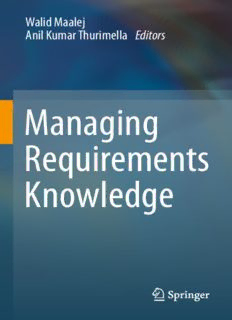Table Of ContentWalid Maalej
Anil Kumar Thurimella Editors
Managing
Requirements
Knowledge
Managing Requirements Knowledge
ThiSisaFMBlankPage
Walid Maalej (cid:129) Anil Kumar Thurimella
Editors
Managing
Requirements
Knowledge
Editors
WalidMaalej AnilKumarThurimella
UniversityofHamburg HarmanBeckerAutomotiveSystemsGmbH
DepartmentofInformatics/MOBIS Munich
Hamburg Germany
Germany
ACMComputingClassification(1998):D.2,K.6,I.2
ISBN978-3-642-34418-3 ISBN978-3-642-34419-0(eBook)
DOI10.1007/978-3-642-34419-0
SpringerHeidelbergNewYorkDordrechtLondon
LibraryofCongressControlNumber:2013940938
#Springer-VerlagBerlinHeidelberg2013
Thisworkissubjecttocopyright.AllrightsarereservedbythePublisher,whetherthewholeorpart
of the material is concerned, specifically the rights of translation, reprinting, reuse of illustrations,
recitation,broadcasting,reproductiononmicrofilmsorinanyotherphysicalway,andtransmissionor
informationstorageandretrieval,electronicadaptation,computersoftware,orbysimilarordissimilar
methodologynowknownorhereafterdeveloped.Exemptedfromthislegalreservationarebriefexcerpts
inconnectionwithreviewsorscholarlyanalysisormaterialsuppliedspecificallyforthepurposeofbeing
enteredandexecutedonacomputersystem,forexclusiveusebythepurchaserofthework.Duplication
ofthispublicationorpartsthereofispermittedonlyundertheprovisionsoftheCopyrightLawofthe
Publisher’s location, in its current version, and permission for use must always be obtained from
Springer.PermissionsforusemaybeobtainedthroughRightsLinkattheCopyrightClearanceCenter.
ViolationsareliabletoprosecutionundertherespectiveCopyrightLaw.
The use of general descriptive names, registered names, trademarks, service marks, etc. in this
publicationdoesnotimply,evenintheabsenceofaspecificstatement,thatsuchnamesareexempt
fromtherelevantprotectivelawsandregulationsandthereforefreeforgeneraluse.
While the advice and information in this book are believed to be true and accurate at the date of
publication,neithertheauthorsnortheeditorsnorthepublishercanacceptanylegalresponsibilityfor
anyerrorsoromissionsthatmaybemade.Thepublishermakesnowarranty,expressorimplied,with
respecttothematerialcontainedherein.
Printedonacid-freepaper
SpringerispartofSpringerScience+BusinessMedia(www.springer.com)
Preface
The Story
Thisbooksynthesizestheworkofthemanagingrequirementsknowledge(MARK)
community during the last 5 years. The first idea to organize a workshop on this
topic came to our minds in winter 2007. We were both working on our Ph.D.
projects at the Technische Universita¨t Mu¨nchen (TUM) under the supervision of
Bernd Bru¨gge. Anil was focusing on software product lines, while Walid was
looking at the application of ontologies and machine learning to collaborative
software engineering, in particular during bug fixing and API reuse. Our fields of
interest seemed divergentat firstglance. However,after acoupleofdiscussions –
alsowithcolleaguesfromindustry–wefoundthatsomeoftheproblemswewere
trying to address are very similar. Valuable experiences and knowledge gained in
the course of software projects, in particular during the work with requirements,
remain tacit in the mind of people. The same problems in understanding and
implementingrequirementsoccuragainandagain.
We were convinced about the need for a new perspective on requirements –
consideringthemasaknowledgeassetinsoftwareorganizations–inadditiontothe
engineering and lifecycle perspectives. We were convinced about the huge
potentials of recent trends such as ontologies, wikis, Web 2.0, recommendation
systems,anddatamining,totherequirementsengineeringcommunity.
In the last years, the MARK workshop successfully took place in Barcelona,
Atlanta, Sydney, and Trento. It has been one of the most successfulworkshops at
the IEEE International Conference on Requirements Engineering that is based on
submission and registration statistics, as well as the feedback of the participants.
The achievements are remarkable. Novel approaches such as “recommending
featuresandstakeholdersbyanalyzingrequirementsrepositories”or“usingseman-
ticwikistorepresentandreasonaboutrequirements”havefoundtheirwaytomain
conferences and journal in the field. Some of the tools are already being used in
practice.
v
vi Preface
With this book, we hope to present a baseline for the community discussion,
enablingmorepeopletojoinandcontribute.Wealsohopetobringmoreresearch
questionsandinitiateevenmorediscussions.Managingrequirementsknowledgeis
anewevolvingfield.Itsrequirementsanditsknowledgeareevolvingaswell.We
inviteyoutocontribute.Enjoyreading!
The Structure
In addition to the introduction and conclusion chapters, which motivate the field,
introducethefoundationsanddefinitions,overviewtheapproachesproposedsofar,
anddiscusstheroadahead,therestofthisbookisstructuredintofiveparts.
PartI.IdentifyingRequirementsKnowledgeshowstheimportanceofidentifying
and externalizing tacit knowledge about requirements such as rationale and
presuppositions.Itcoverstheoreticalframeworkstomodeltacitknowledge,empir-
icalstudiestoinvestigateminingrequirementsknowledgefromprojectartifacts,as
well as pragmatic and practical discussion on what is requirements knowledge in
practiceandhowtomanagewithoutintroducingadditionaloverhead.
PartII.RepresentingRequirementsKnowledgeforReuseintroducestechniques
such as patterns and ontologies to represent requirements knowledge for both
humans and machine, enabling an efficient knowledge access for various
stakeholders. We focus on techniques which support reuse of knowledge within
andbetweensoftwareprojects.
Part III. Sharing Requirements Knowledge is about people, i.e., requirements
stakeholders, and the exchange of knowledge among them. This part discusses
knowledge-sharingtoolssuchassocialmediaandWeb2.0forrequirementsaswell
asmethodologiessuchasagilerequirementsandquestionasking.
Part IV. Reasoning About Requirements discusses how to reason about the
interdependencies of requirements and their knowledge. The goal is to check
consistency and derive new knowledge. Also the integration of requirements
knowledgeintoothersoftwareengineeringknowledgeisdiscussed.
Finally,PartVIntelligentToolSupportfocusesonthetoolperspective,andon
howtoapplynoveltechniquessuchasrecommendationsystems,experience-based
tools,aswellasintegrateddevelopmentenvironmentstodealwiththeinformation
overload, and the huge amount of knowledge related to requirements in large,
complex,distributedprojects.
The Audience
Therearenospecialprerequisitestoreadthisbook.Wetriedourbesttoaddressthe
needsofthefollowingtargetgroups:
Preface vii
(cid:129) Researchers from the area of knowledge management with interests on
requirementsengineering
(cid:129) Researchersfromtheareaofrequirementsengineeringwithinterestsonknowl-
edgemanagement
(cid:129) Industrial practitioners involved in requirements engineering and outsourcing
projects
(cid:129) Lecturers, students, and practitioners interested in the state of the art of
requirementsengineering
ThiSisaFMBlankPage
Acknowledgments
This work would not have been possible without the great support of many
individuals.First,wewouldliketogreatlythanktheMARKcommunity,including
all authors, attendants, reviewers, and the other co-organizers for all the
contributions and the great constructive discussions. In particular, we would like
tothanktheauthorsofthebookchapters,whosenamesarelistedintheauthorlistat
the end of this book. Thanks to these authors for writing the chapters, reviewing
otherchapters,theircommitments,andallthehardworkanditerationstobringour
bookvisionintoreality.
We would also like to thank our external reviewers, namely, Barbara Paech,
Rick Rabiser, Yang Li, Pete Sawyer, Smita S Ghaisas, Dennis Pagano, and
ZardoshtHodaie,fortheirdetailedandconstructivefeedback.
Heidi Oskarsson helped with formatting matters. Ralf Gerstner and Viktoria
Meyerof Springer gave invaluable advice for management andpublishing issues.
Finally,wecanhardlythankenoughourfamiliesfortheirpatiencewhenwewere
spendingournightseditingthisbookandfortheirconstantlove.
November2012 WalidMaalej
AnilKumarThurimella
ix
Description:Requirements engineering is one of the most complex and at the same time most crucial aspects of software engineering. It typically involves different stakeholders with different backgrounds. Constant changes in both the problem and the solution domain make the work of the stakeholders extremely dyn

